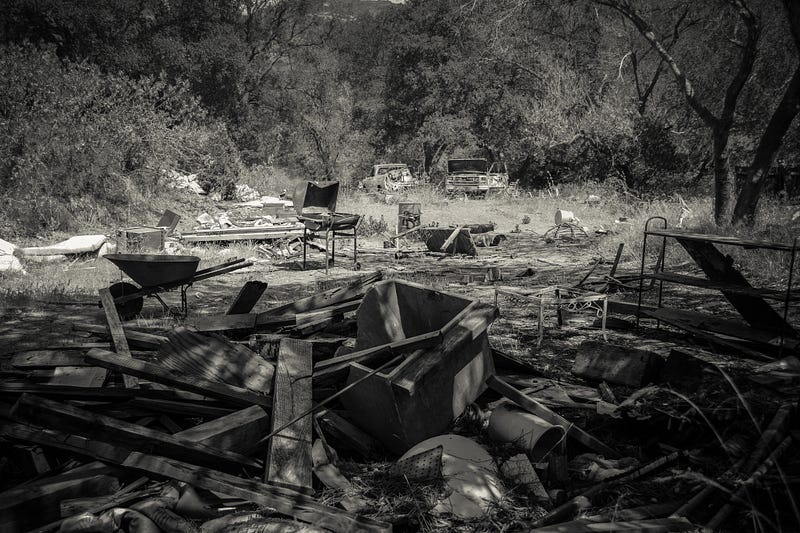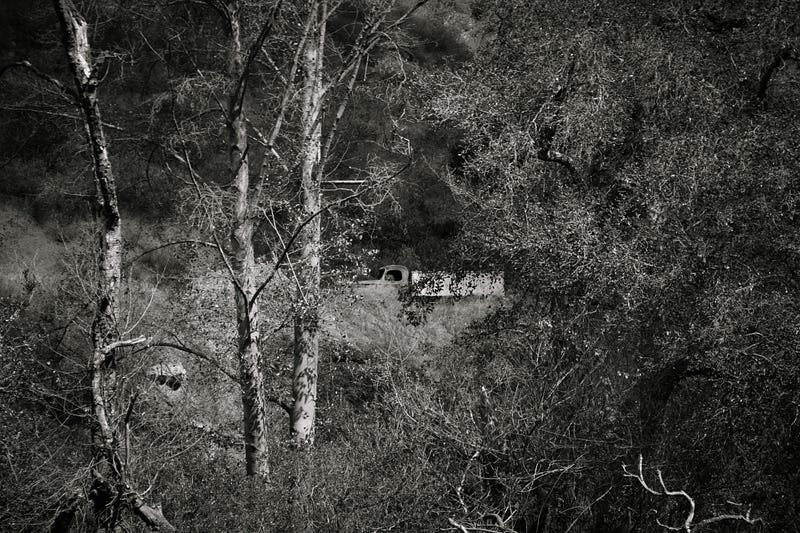Black Star Canyon Your safety cannot be guaranteed.
Your safety cannot be guaranteed.
Story and photos by Adam Ernesto Fuentes

It’s the weekend, and you thirst for adventure. You look for something new, something exciting, and something eventually peaks your interest. A mysterious trail that you have never heard of comes up on a computer search. The description is vague and many urban legends reside there. You get a sense that this place holds more secrets than it reveals. At the end of the trail is a remote waterfall where the water rushes out from an abandoned mine shaft. The locals consider making this journey at night as a right of passage. Many compare it to Paranormal Activity and The Blair Witch Project. You decide to brave this place in the daytime. You wear your lightest pair of clothes, strap on a camera bag, and enlist one or two friends on to the adventure — not for the company but because there is safety in numbers. In Black Star Canyon, your safety is not guaranteed.

You take a drive toward the Cleveland National Forest. The canyon is wedged between the City of Orange and Irvine Lake about 35 miles southeast of Los Angeles. Santiago Canyon Road turns into Black Star Canyon Road. You follow it down to the turn out and park. The trail looks inviting and serine. To your left you see flower fields and to your right a dry creek bed and grass lands at the foot of long rolling hills.
The Tongva tribe inhabited most of the Los Angeles basin before being driven out by the Spanish and Americans. Two hundred years ago the canyon was witness to a bloody clash between Native Americans and American colonizers. Traces of the Tongva are still visible today. But the conflict was not the last time blood was shed in the canyon.
Follow the paved trail for about half a mile. A sign points you toward the right. You begin an uphill hike into the canyon. Along the trail are markers that guide you through the canyon. The markers are dotted with bullet holes. This is not the kind of place you would like to brave at night. Legend has it that a homeless nomad by the name of Black Star Bill will gun down anyone traveling through alone. Many claim to see ritual fires lit up by the Ku Klux Klan burning at night. Swastikas are carved in the stones here. The paved trail gives way to a dust road.

For years, Black Star Canyon has shifted owners between private enterprise, local, and federal governments. Who owns the area is just as ambiguous as the trail itself. Along the path, you will hike beside electric fences meant to keep trespassers off of the private land adjacent to the trail. You cross the first bridge over a creek. On the railing, a message reads:
I’m Watching =)
There are fake signs put up by squatters to discourage you from going further. Police reports warn about property owners firing rounds of bullets into the air to keep you from making the journey at night. You spot a trail of debris on the left-hand side at the other side of the dry creek below. The barbwire fence is destroyed and you decide to climb down to the creek bed and up to the debris field above. As you climb up you come across a screwdriver with a jagged edge that is covered in red paint. You wonder to yourself if this is your destiny ominously foreshadowing your demise.

There are many empty gas tanks consumed with rust. A wood shed is full of nails and saw blades. As the wind howls through the canyon walls, everything billows in the trees. You get a sense that you are being watched. You look over your shoulder always keeping a mindful eye on your company. You all split up like a CSI team at a murder scene. There are children’s toys, broken Christmas lights wrapped in the branches, and a rusted swing creaks and moans against the wind.
On one edge of the debris are two Ford trucks. Their hoods are up and their windshields are broken in. Their seats are torn and the inside compartments are gutted out. You move in close, inspecting for someone sleeping within the broken glass. The coast is clear. Movies like Texas Chainsaw Massacre, Cabin in the Woods, and Wrong Turn play in your head. You become anxious and scared but you are too afraid to admit it. Your friends are off taking Instagram pictures paying no attention to your apprehension. You check underneath the wreckage just to be sure nothing will pull you under.



On the other side of the rubble a metal compartment reads:
He’s Going To Kill You
It is time to go. You climb back in to the creek bed and up on the other side; this time with a sense of urgency instead of curiosity. You are back on your way but the feeling of being watched does not shake off easily. You pass over a second bridge. The message reads:
I See You =)
The third bridge comes quickly. This time there is no eerie message. A sign warns that you are heading into land that is not maintained by Orange County. The county will not be responsible for any loss or injury suffered from this point on. But it might just as well have been another eerie message…

Around this spot local residents tell a story of a school bus that veered off the road into the creek killing the driver, a teacher, and most of the children onboard in the 1970s. Hikers have reported seeing shadows and hearing screams of children trapped in the wreckage. The bus was removed in 2012, but the ghosts of those who died are said to still wander the woods at night. You are very close to what you came here for. You are very close to seeing a sight that not many people have even heard of let alone hiked to — the elusive Black Canyon Falls. You pay close attention; the next set of instructions are crucial to reaching the falls. If you make a wrong turn the trail will lead you to a water tower instead. You pass a house with a mini golf course and a rusted water tank.

When you get to a very round turn there is a tendency to keep going upward into a steady ascent, and if you do, you will go the wrong way. Instead, you look to your right; there is a small dirt path next to a wooden fence. Follow the narrow path down to the creek bed. From here on you make your own trail. You are deep between the canyon walls. The overgrown vegetation towers over you. Turn left. This is the most strenuous part of the hike. You climb up the river through fallen trees and jagged rocks. You help each other climb over and in between boulders as tall as a one story house. As you progress through the rocks, the climb gets tougher and tougher.

The trail is about six to seven miles, and a four to six hour hike. You reach the end, and a towering canyon wall encompasses you. During the summer and fall seasons the waterfall is dry. The best time to visit is in the spring. The water cascades down from the top of a cliff and through a collapsed mine shaft. Its unusual and haunting shape has led many to believe the waterfall is just an urban legend itself. Remember the Native American massacre? Hikers and residents alike have reported hearing chanting and the beating of drums coming from the mineshaft.

With the water source running dry and the rock exposed, you decide to climb into the shaft. The rocks are green with cultures of moss growing in the foot holes as you climb up. It is a muddy task. Inside the mine shaft are two chambers- one of them is a dead end, the other has its roof exposed and a stranger has tied a rock climbing rope to a second level. You tug on it, nothing happens. Your distrust gives way to your curiosity and you climb up. Its tricky, and you are exhausted from the hike, but once you are at the top you have a chance to catch your breath.


All of you come to a consensus: If the zombie apocalypse happened today, Black Star Falls would be the best place to wait it out.

Substance is a publication of the Mt. San Antonio College Journalism Program. The program recently moved its newsroom over to Medium as part of a one-year experiment. Read about it here.







